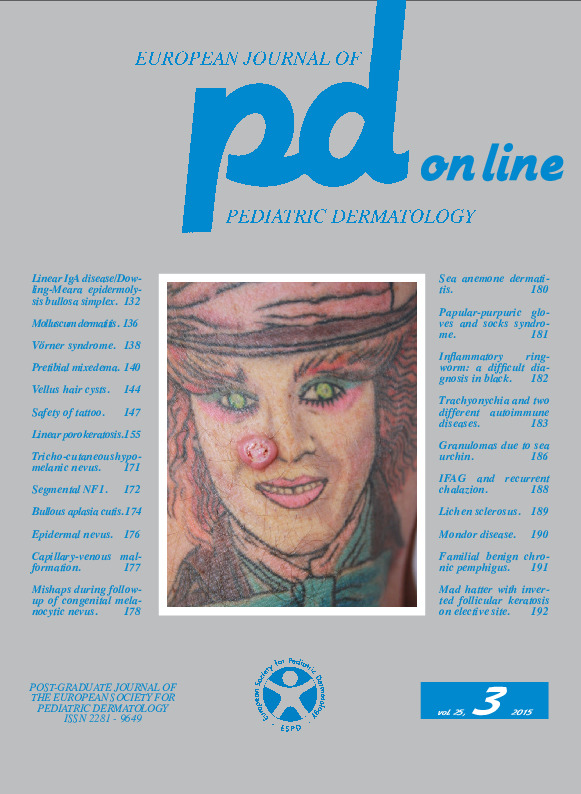Trachyonychia and two different autoimmune diseases in the same subject: three cases with a 20-year follow up.
Downloads
DOI:
https://doi.org/10.26326/2281-9649.25.3.1147How to Cite
Bonifazi E. 2015. Trachyonychia and two different autoimmune diseases in the same subject: three cases with a 20-year follow up. Eur. J. Pediat. Dermatol. 25 (3):183-85. 10.26326/2281-9649.25.3.1147.
pp. 183-185
Abstract
Skin disorders with different clinical features best express their differences on the glabrous skin: when these diseases affect particular locations like the mouth, scalp or nails, the differences between them become blurred because partially obscured by the characteristics of the affected site; it can happen so that diseases very different from each other, such as psoriasis and alopecia areata, express themselves at the nail level with similar characteristics, such as pitting or trachyonychia. You can ask yourself whether trachyonychia, which we observe in numerous diseases (2), especially autoimmune and particularly alopecia areata, psoriasis and lichen planus, has histological features that allow to go back to the skin disorder of which it is a manifestation. According to the literature when trachyonychia is associated with psoriasis, the histological findings - acanthosis, parakeratosis, accumulation of neutrophils - are also similar in the nail (4); however, there are cases of trachyonychia associated with psoriasis characterized by hypergranulosis (2), which is certainly not characteristic of psoriasis. The answer to this question becomes even more complicated when we examine the histology of trachyonychia associated with alopecia areata (4), usually characterized by eczema-like findings - spongiosis, exocytosis - but sometimes presenting findings typical of lichen planus (3), leading the Authors of this case to state that trachyonychia clinically associated with alopecia areata was not due to alopecia, but to lichen planus expressing itself only in the nail; moreover, there are the much more numerous cases of the so-called idiopathic trachyonychia whose histological findings usually consist of spongiosis and exocytosis (2).Regardless of the discrepancy between clinical and pathological findings, we must also think of the discrepancies between the clinical course of trachyonychia and that one of the associated disease. In children psoriasis and alopecia areata exceeding 10% of scalp involvement are chronic diseases recurring for decades; on the other hand, trachyonychia associated with these conditions is usually a unique episode that finally subsides after a few years.
Our 3 cases are characterized by long monitoring – 20 years on average – and by the presence of 2 autoimmune conditions in addition to trachyonychia; in literature exists another case (1) of trachyonychia associated with psoriasis and alopecia areata. In our first case and in that one of Dogruk et Al. (1) it is difficult to say whether trachyonychia is to be considered associated with psoriasis or alopecia areata. Even more difficult it is to give one's opinion in our second and third case in which trachyonychia is associated with autoimmune disorders not affecting usually the nail plate such as celiac disease and lichen sclerosus in the third case or scleroderma in the second case; in this second case trachyonychia affecting the second, third and fourth finger of the right hand at the age of 4 can not be considered in relation with annular lichen planus affecting only the right breast at the age of 24.
These clinical discrepancies and the inconstant correlation between the clinical disorder associated with trachyonychia and the histologic nail findings lead us to hypothesize that trachyonychia is an autoimmune condition in its own right: it may be associated with other autoimmune diseases as thyroiditis is associated with vitiligo, although in some cases trachyonychia may assume the same histological aspects of psoriasis or lichen planus associated with it.
Keywords
Trachyonychia, Autoimmunity

